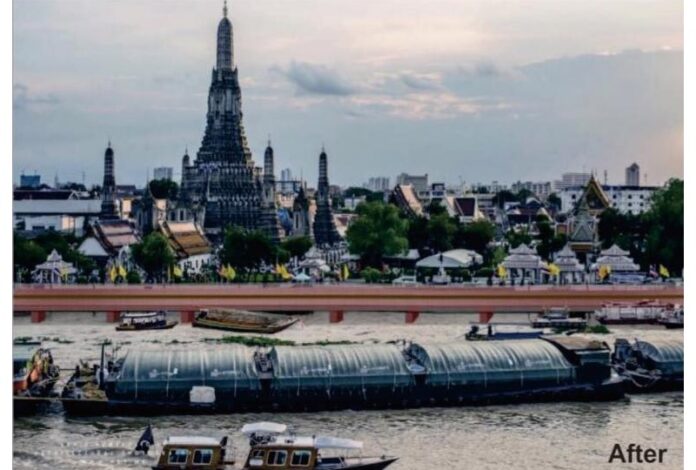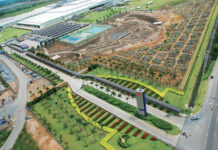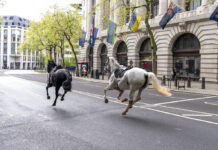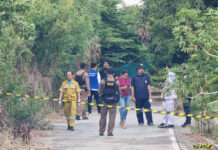
BANGKOK — Professionals, business owners, activists and others who consider themselves friends of the Chao Phraya River united Wednesday to call for the military government to abandon its plans to pour a concrete walkway along its banks.
Gathering to show fierce opposition to what they describe as a “three-lane highway on the river,” members of Friends of the River and their allies from architecture, engineering and even pop music focused on the legal flaws of the junta’s project to redevelop a prime stretch of the river, a project expected to go out for bidding this month.
“We have found irregularities in the project that could lead to damage to the Chao Phraya River, which is an invaluable national asset,” said Yossapon Boonsom, the landscape architect who started the movement two years ago. “And it can’t be undone.”
The group makes clear they do not oppose redeveloping the river in principle. But they are unconvinced by plans to build a concrete boardwalk along its banks. They urged the government to delay construction until a sincere legal and well-rounded review is conducted.
“Why is it rushed, why is it secret and what is the disadvantage to not building it?” singer Chulachak “Hugo” Chakrabongse said to a packed room at the Bangkok Art and Culture Centre.
The military government promoted the plan soon after to seizing power in 2014, saying it wanted to remake the river into a world-class fixture of Thailand’s greatness.
City Hall announced Friday it will seek cabinet approval for plans to put the first 8.3 billion baht contract out for bidding this month. Stretching for seven kilometers on both sides of the river, the first phase would extend from the Rama VII to the Phra Pinklao bridge. It is expected to be completed by early 2019.
Flawed From the Start
Among the project’s shortcomings, the group said it lacks a comprehensive feasibility study, and they faulted the regime for failing to disclose important details to the public, despite the massive impact the project will have by remaking the river.
“The renderings are imaginary and sometimes conceal the potential problems,” the president of the Association of Siamese Architects Under Royal Patronage, Ajaphol Dusitnanond, said of promotional materials distributed by the study team.
City Hall has said it reduced the project’s footprint by nearly halving the width of the boardwalks to between seven and 10 meters. Opponents say that doesn’t change the fact that concrete will be poured along both sides of the river at the cost of everything that is there now, including longstanding riverside communities.
They believe moving forward with the project at this stage is illegal and potentially devastating for the environment.
“Imagine the effects of driving piles for 14 kilometers,” Tortrakul Yomnak, former president of the Engineering Institute of Thailand, said of 80-centimeter pylons called for every 15 to 20 meters in the contract. “When it’s done, it will be the ugliest thing ever.”
Apart from that, the group repeated again that the study and design completed by two universities could not be used because they were not licensed to do the work. Both King Mongkut’s Institute of Technology Ladkrabang and Khon Kaen University, which received 120 million baht for the work, responded in September by saying every person involved was a licensed architect.
“But who will take the legal responsibility, the professors or the consultant they subcontracted?” said Krai Tungsa-gna of the Consulting Engineers Association.
Representatives from the private sector – riverside hotels, restaurants and boat operators – also joined to express their disagreement as it is certain the walkway will worsen business.
Marisa Sukosol Nunbhakdi, representing the Sukosol hotel group, said she saw the design for the first time late last month when the study team came to talk to her.
“No one could give numbers involving the probable impact on business and tourism after the promenade construction finishes,” she said.
By encroaching into the river, the planned bicycle-friendly concourse may be less so for marine traffic.
The Chao Phraya will become 10 percent narrower if the structure finished as planned. Sutee Supaporn from the Thai Boats Association said that will affect marine traffic by lengthening the time it takes to traverse the river and therefore driving out vital shipping.
Even without technical and legal knowledge, some said it only takes common sense to see through the junta’s ambition to build a “landmark of the nation.”
“They have good intentions, but they don’t understand,” said prominent environmental activist, Sasin Chalermlarp. “The Chao Phraya River today is already a landmark in itself.”
Related stories:
Chao Phraya Promenade Project to Make Progress in April
Lacking Leverage or Clout, River Residents Give Up Homes For Boardwalk
Riverside Communities Evicted for Chao Phraya Makeover
Architect Council Says University Can’t Actually Design River Project
Riverside Design Dropped Under Cloud of Plagiarism Charges
Top Architect Says River Project Plagiarized Design
Opponents, Proponents of Chao Phraya Boardwalk Open Fire
Locals Ready to be Evicted for Chao Phraya Boardwalk, Official Says
River’s Friends Float Hope for Public Hearings on 14B-Baht ‘Promenade’
Radical Makeover of Chao Phraya River Delayed
Chao Phraya Promenade Should be Sent Back to Drawing Board, Architects Say

















































